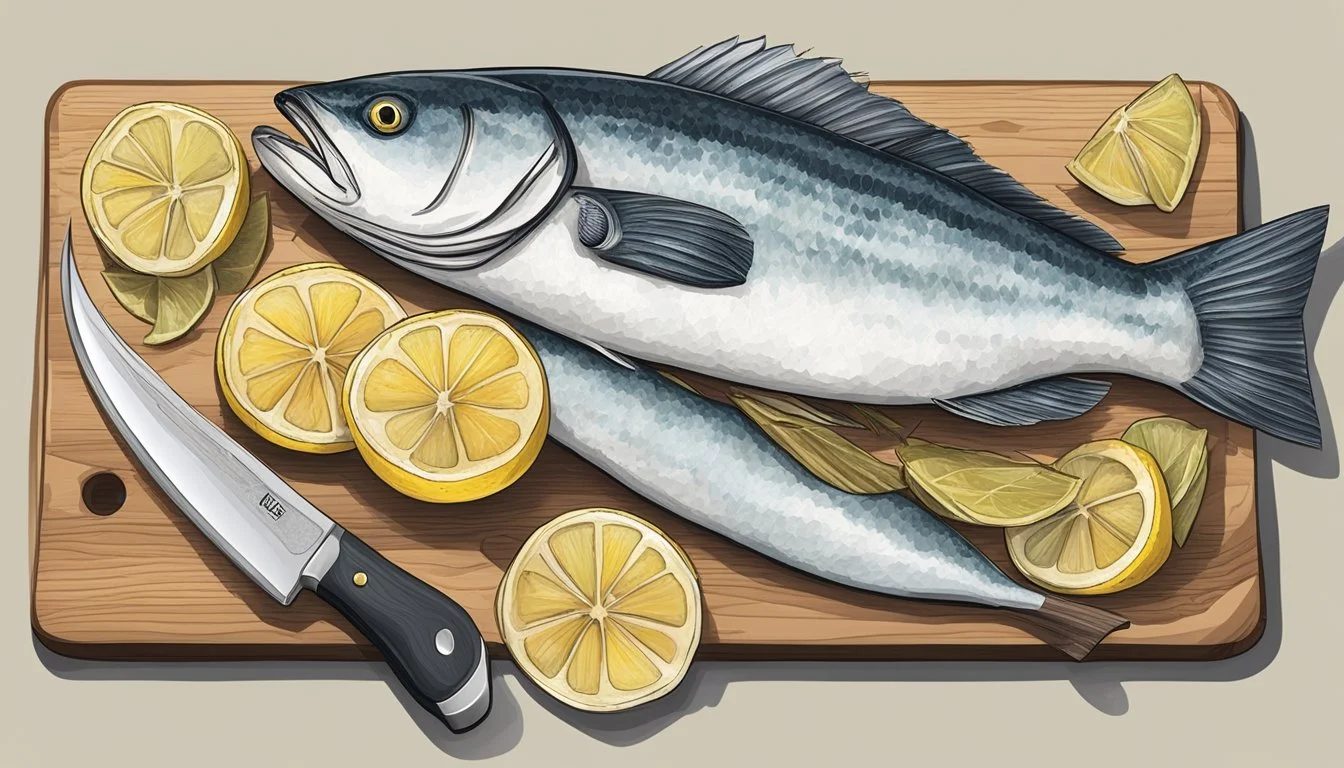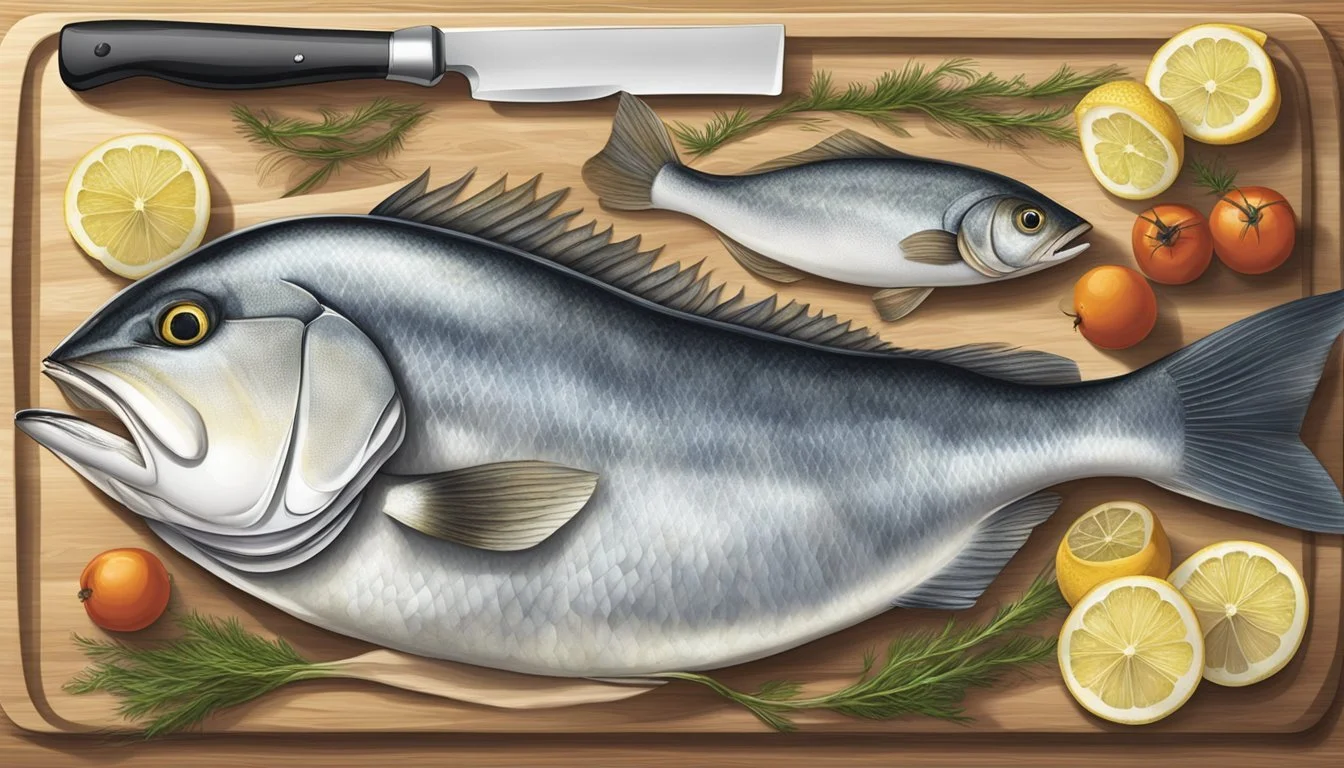Halibut Substitutes
Best Alternatives for Your Recipes
Finding the perfect substitute for halibut can be essential for cooking enthusiasts looking to explore new flavors or save on costs. This versatile fish is praised for its firm texture and mild taste, making it a favorite in many recipes. Cod, with its flaky flesh and ability to integrate with various ingredients, stands out as an excellent alternative to halibut.
Other notable substitutes include grouper and dogfish. Grouper's dense, white flesh and firm consistency mimic halibut's texture, while its mild flavor adapts well to different seasonings. Dogfish also offers a mild and subtly sweet flavor, and its white, dense meat holds up well under various cooking methods, such as grilling and baking.
For those seeking more options, flounder, turbot, striped bass, haddock, fluke, sole, and tilapia also make great substitutes. Each of these fish varieties shares similarities in texture or flavor with halibut, ensuring that your dishes maintain the desired consistency and taste. Choosing the right substitute can elevate your culinary creations while offering variety and flexibility in your kitchen.
Understanding Halibut
Halibut is a popular flatfish known for its firm texture and mild flavor. It is versatile in cooking methods, allowing chefs to prepare it in various styles, whether fresh or frozen.
Physical Characteristics
Halibut is notable for its large, flat body, typically found in the North Atlantic and northern Pacific oceans. It has a white belly and dark, mottled top, allowing it to blend into the ocean floor. These fish can grow to impressive sizes, some exceeding 400 pounds. Halibut has white, dense flesh with a firm texture. The fillets are thick and uniform, making them ideal for various cooking techniques. Much of their appeal comes from their robust size and consistency.
Flavor Profile
Halibut is prized for its delicate, mild flavor. The taste is subtle, without the strong fishy essence found in other seafood. This mildness allows it to blend well with a wide range of seasonings and sauces, making it a favorite in various cuisines. The fish's flesh is flaky yet firm, providing a satisfying texture that holds up well to different cooking methods. Its flavor profile makes it suitable for both simple and elaborate dishes.
Common Cooking Methods
Halibut can be prepared using numerous cooking techniques. Popular methods include grilling, baking, broiling, and poaching. Its firm texture allows it to hold up well under high heat, making it perfect for grilling and broiling. Baking halibut helps retain its moisture, making for a tender, juicy dish. Poaching, on the other hand, infuses it with subtle flavors and keeps the flesh delicate. Each method highlights the fish's mild flavor and versatile nature. Whether using fresh or frozen fillets, halibut remains a staple in many kitchens.
Top Substitutes for Halibut
When halibut is unavailable, there are several versatile fish options with similar textures and flavors. The following substitutes are reliable choices for mimicking the qualities of halibut in various recipes.
Cod
Cod is a well-known fish characterized by its mild flavor and flaky texture. It is widely available, making it a convenient substitute for halibut.
Its white flesh holds together well during cooking, whether you bake, grill, or fry it. Cod is also rich in nutrients like vitamin B12 and omega-3 fatty acids, making it a healthy option for many dishes that typically use halibut.
Haddock
Haddock shares many characteristics with cod, making it another excellent substitute for halibut. It has a slightly sweeter taste and a finer flake, which works well in recipes requiring delicate fish.
Haddock performs best when baked, grilled, or broiled, holding its structure without falling apart. It is also a great source of protein and low in fat, making it suitable for those seeking a lighter alternative to halibut.
Flounder
Flounder is a versatile fish with a delicate flavor and mild sweetness. Its lean, white flesh takes on seasonings well and can be cooked using various methods, including baking, pan-searing, and poaching.
Although flounder is thinner than halibut, it still provides a satisfying texture and taste. It is low in calories and fats, yet rich in protein and vitamins, making it a nutritious and adaptable substitute.
Sole
Sole is known for its mild, sweet flavor and smooth texture. This fish is similar to flounder but often considered to have a finer, more elegant taste.
It is a good substitute for halibut in recipes requiring a delicate and refined fish. Sole is best cooked by pan-searing, baking, or poaching, as these methods retain its tender qualities without overwhelming its subtle flavors.
Tilapia
Tilapia is a widely farmed fish that has a mild flavor and firm texture, similar to halibut. It is often more affordable and accessible, making it a practical alternative for various dishes.
Tilapia can be baked, grilled, or pan-fried, absorbing spices and marinades well. Nutritionally, it is a good source of protein and low in fat, which makes it a healthy choice for replacing halibut in numerous recipes.
Alternative Fish Varieties
When looking for substitutes for halibut, several options are available that match its flavor and texture profile. Each alternative has specific characteristics that may make it more suitable for particular cooking methods.
Striped Bass
Striped bass is known for its tender, flaky flesh, making it a suitable halibut alternative. It has a mild flavor that works well in a variety of dishes. This versatile fish can be baked, grilled, or roasted, maintaining its moisture and texture. Striped bass is often available at fish markets and can be sourced both farmed and wild-caught.
Turbot
Turbot is a flatfish often compared to halibut due to its delicate texture and rich taste. Its flesh is firm yet tender, providing a buttery mouthfeel when cooked. Turbot can be prepared using methods such as baking or pan-searing. It is especially valued in European cuisine and can be found in specialty markets.
Pacific Halibut
Pacific halibut, although a halibut species itself, can be used interchangeably with its Atlantic cousin. It shares the firm texture and mild flavor characteristic of halibut. This fish is especially suited for grilling, as it holds its shape well and resists drying out. Pacific halibut is commonly available in North American markets and is a sustainable choice.
These fish provide both versatility and comparable culinary qualities to halibut, allowing for seamless substitution in various recipes.
Nutritional Considerations
When considering substitutes for halibut, it's important to evaluate their nutritional profiles, paying close attention to protein, fatty acids, vitamins, and minerals. This will help ensure you're making a healthy and informed choice.
Protein and Fatty Acids
Many halibut substitutes are lean fish, which are known for their high protein content and low-fat profile. Flounder and sole offer protein contents similar to halibut, providing essential amino acids for muscle repair and growth.
Tilapia: A popular choice, tilapia is rich in protein and provides about 23 grams per serving.
Cod: Another excellent option, cod offers roughly 20 grams of protein per serving.
Omega-3 fatty acids are also a crucial consideration. While halibut is a good source of these heart-healthy fats, alternatives like swordfish and striped bass also contain significant amounts, benefiting cardiovascular health and supporting brain function.
Vitamins and Minerals
When replacing halibut, it's essential to look for fish that provide similar vitamins and minerals, such as vitamin B12, selenium, and potassium.
Flounder: Rich in vitamin B12 and selenium, crucial for nerve function and antioxidant protection.
Haddock: Offers notable amounts of vitamin B6 and B12, supporting metabolism and red blood cell formation.
Many of these fish are high in potassium, which helps maintain healthy blood pressure levels. Additionally, iron and magnesium found in substitutes like cod and sole contribute to overall body functions and energy levels. Using nutrition-rich fish will ensure that dietary needs are met without compromising on health benefits.
Cooking Techniques for Fish Substitutes
Cooking techniques for fish substitutes can vary based on the type of fish and desired outcome. Whether grilling, baking, or pan-frying, each method has its specifics to ensure optimal flavor and texture.
Grilling and Broiling
Grilling and broiling are ideal for fish substitutes with a firmer texture, such as swordfish and striped bass. Grilling is done on an open flame, often outdoors, whereas broiling takes place under direct heat in the oven.
For both methods, it is essential to preheat the surface to avoid sticking. A marinade with lemon, olive oil, and herbs can enhance the flavor. Grill the fish for 4-5 minutes per side. Use a spatula to handle the fish gently to prevent it from breaking apart.
Swordfish and striped bass hold up well to high heat, making them excellent choices for these methods.
Baking and Poaching
Baking is perfect for fish with a delicate, flaky texture, such as sole and tilapia. Preheat the oven to around 375°F. Place the fish in a baking dish, season with lemon juice, salt, and pepper, and optionally add a few pats of butter. Cover with foil to retain moisture.
Poaching involves cooking fish in simmering liquid, like broth or water. This method is gentle and preserves the tender texture of the fish. For a flavorful poaching liquid, add herbs and lemon slices. Cook the fish until the internal temperature reaches around 145°F.
These methods help maintain the fish's moisture and subtle flavors.
Pan-Frying and Searing
Pan-frying and searing are suitable for fish with a denser and meatier texture, such as dogfish and halibut substitutes. Pan-frying requires a small amount of oil heated to medium-high. Lightly flour the fillets to get a crispy exterior.
Searing involves cooking the fish on high heat for a short time until a golden crust forms. This method locks in moisture and enhances flavor. Use a mixture of butter and oil to prevent burning. Cook each side for 3-4 minutes, depending on thickness.
These techniques are excellent for achieving a crisp texture while keeping the fish moist inside.
Selecting Fresh and Frozen Fish
When choosing fish, it is essential to understand the differences between fresh and frozen options.
Fresh Fish: Fresh fish should have a mild ocean scent. The flesh should be firm, moist, and slightly elastic. Look for bright, clear eyes and vibrant scales in white fish.
Frozen Fish: Frozen fish can be just as good if properly handled. Ensure that the fish is solidly frozen with no signs of frost or ice crystals.
Fish Markets: Fish markets are excellent places to find fresh catches. Always inquire when the fish was caught to ensure maximum freshness.
Tips for Selecting Different Types of Fish
Flatfish: Often used for dishes like fish and chips due to their delicate flavor and flaky texture.
White Fish: Look for a subtle scent and firm texture.
Storage and Handling for Best Results
Fresh Fish: Use within two days of purchase. Store in the coldest part of your refrigerator, ideally on a bed of ice.
Frozen Fish: Keep at a stable temperature in your freezer. Thaw slowly in the refrigerator to preserve texture and flavor.
By paying close attention to these details, selecting the best fresh and frozen fish can be straightforward and rewarding.
Seasoning and Flavor Pairings
Choosing the right seasoning and flavor pairings can elevate halibut substitutes like flounder, tilapia, and cod to new culinary heights. Versatile herbs, spices, and sauces enhance these fish's mild yet slightly sweet flavor.
Herbs and Spices
Herbs such as dill, parsley, and chives complement the delicate flavor of halibut substitutes. Fresh dill adds a slightly sweet taste, making it a great choice for fish like flounder and tilapia.
Parsley provides a fresh and mild flavor that pairs well with mildly flavored fish. For a bit of heat and complexity, incorporating black pepper, paprika, and cayenne into the seasoning mix adds depth without overpowering the fishy taste.
Sauces and Butters
Lemon-dill butter or a simple garlic herb butter enhances the meaty texture of halibut substitutes, offering a rich and juicy bite. Creamy sauces like béarnaise or hollandaise serve well with fish like cod and fluke.
A Mediterranean sauce with olive oil, garlic, tomatoes, and capers provides a bright, tangy counterpoint to the mild flavor, creating a harmonious culinary combination. For those seeking more exotic flavors, miso butter or soy-ginger sauce adds an umami-rich component to the meal.
Culinary Combinations
Combining halibut substitutes with specific ingredients can create a well-rounded dish. For a North Atlantic-inspired soup, use dogfish with root vegetables and a touch of cream.
Tilapia can be paired with citrus fruits and fresh herbs to enhance its slightly sweet taste. Flounder works excellently with light vegetable medleys, while swordfish is robust enough for hearty side dishes like roasted potatoes and garlic spinach.
Incorporating seasonal vegetables such as asparagus, zucchini, and cherry tomatoes brings out the best in these fish substitutes, allowing each ingredient to shine without overshadowing the others.
Sustainable Seafood and Eco-Friendly Choices
Choosing sustainable seafood is crucial to preserving ocean ecosystems. Opting for eco-friendly fish reduces overfishing and helps sustain marine biodiversity.
Halibut Substitutes that are more sustainable include:
Flounder
Turbot
Striped Bass
Tilapia
Haddock
These alternatives share similar texture and flavor with halibut.
Pacific Halibut is generally more sustainable than Atlantic halibut. It is managed under strict regulations ensuring minimal environmental impact.
Dover Sole provides another eco-friendly option. This fish is often caught in a manner that reduces bycatch and environmental damage.
Table of Sustainable Choices:
Fish Type Suitable As Substitute Eco-Friendly? Flounder Yes Yes Turbot Yes Yes Striped Bass Yes Yes Tilapia Yes Yes Haddock Yes Yes Pacific Halibut Yes Yes Dover Sole Yes Yes
Sourcing seafood responsibly means considering the method of capture. Techniques like pole and line fishing, trolling, and sustainable aquaculture reduce negative impacts on the ocean.
Consumers can also refer to guides such as the Seafood Watch program to make informed decisions, ensuring their choices align with sustainability goals. Always look for certifications like MSC (Marine Stewardship Council) or ASC (Aquaculture Stewardship Council).
Promoting sustainable and eco-friendly choices plays a significant role in protecting the ocean for future generations.
Buying Guide for Halibut Substitutes
When looking for a substitute for halibut, consider options that have a similar texture and mild flavor.
Flounder is an excellent choice due to its delicate, sweet taste.
Sole offers a soft texture and can be found in many fish markets.
For a more robust flavor, swordfish works well, especially for grilling or baking.
Here are some affordable options to consider:
Tilapia: Widely available and known for its mild taste. It adapts well to various cooking methods.
Cod: Known for its flaky texture and mild flavor, it is versatile and easy to find.
Haddock: Similar in texture to cod, with a slightly stronger taste.
Comparison Table
Substitute Texture Flavor Suitable Cooking Methods Flounder Delicate, flaky Mild, sweet Baking, pan-frying, grilling Sole Soft, subtle Sweet Baking, poaching, sautéing Swordfish Dense, meaty Robust Grilling, baking, pan-frying Tilapia Mild, firm Mild Baking, grilling, pan-frying Cod Flaky, firm Mild Baking, grilling, frying Haddock Flaky, firm Slightly strong Baking, frying, grilling
Buying from local fish markets ensures freshness. These markets often have knowledgeable staff to help you choose the right substitute. Look for fish that have clear eyes and shiny skin.
By focusing on texture and flavor, it's possible to find suitable and versatile substitutes for halibut.











